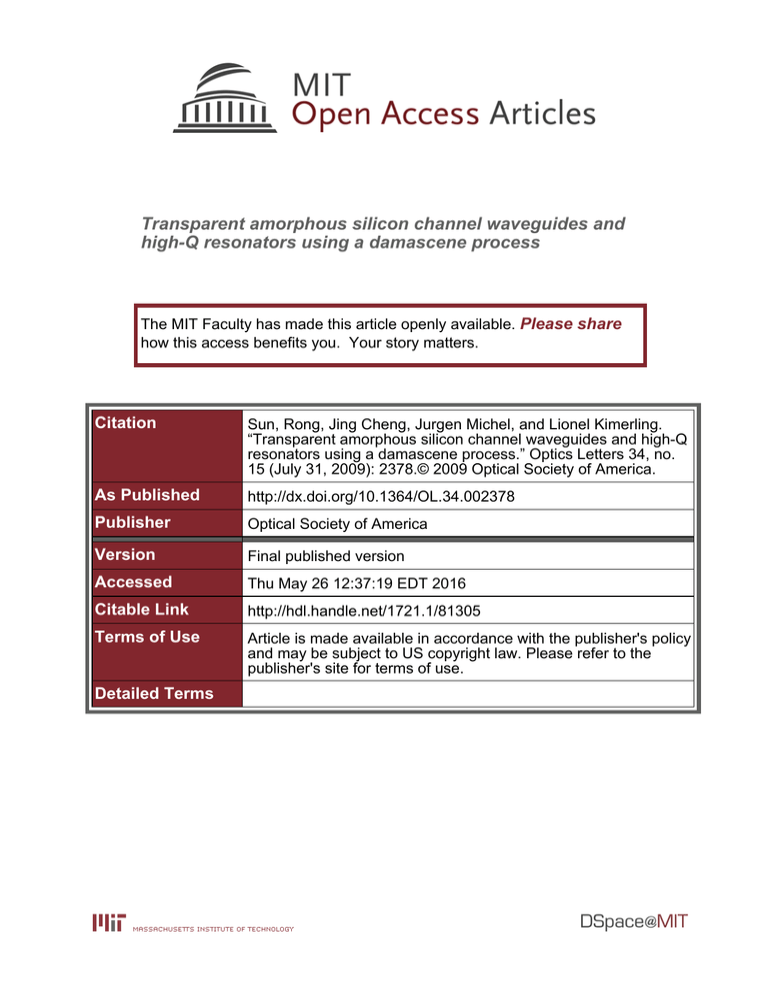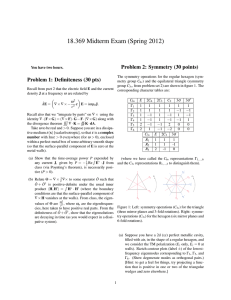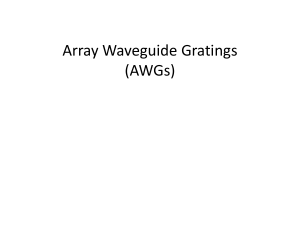Transparent amorphous silicon channel waveguides and Please share
advertisement

Transparent amorphous silicon channel waveguides and high-Q resonators using a damascene process The MIT Faculty has made this article openly available. Please share how this access benefits you. Your story matters. Citation Sun, Rong, Jing Cheng, Jurgen Michel, and Lionel Kimerling. “Transparent amorphous silicon channel waveguides and high-Q resonators using a damascene process.” Optics Letters 34, no. 15 (July 31, 2009): 2378.© 2009 Optical Society of America. As Published http://dx.doi.org/10.1364/OL.34.002378 Publisher Optical Society of America Version Final published version Accessed Thu May 26 12:37:19 EDT 2016 Citable Link http://hdl.handle.net/1721.1/81305 Terms of Use Article is made available in accordance with the publisher's policy and may be subject to US copyright law. Please refer to the publisher's site for terms of use. Detailed Terms 2378 OPTICS LETTERS / Vol. 34, No. 15 / August 1, 2009 Transparent amorphous silicon channel waveguides and high-Q resonators using a damascene process Rong Sun,* Jing Cheng, Jurgen Michel, and Lionel Kimerling Department of Materials Science and Engineering, MIT Microphotonic Center, Massachusetts Institute of Technology, Cambridge, Massachusetts 02139, USA *Corresponding author: rsun@mit.edu Received June 9, 2009; accepted June 29, 2009; posted July 20, 2009 (Doc. ID 112534); published July 31, 2009 We demonstrate a damascene process for fabricating amorphous silicon (a-Si), single-mode optical channel waveguides and high-Q racetrack resonators. This process is compatible with thermal budget limitations for a-Si phase stability. It offers improved optical transmission and facilitates hydrogen encapsulation for process integration of a-Si waveguide cores. At 1550 nm, the average measured transmission loss coefficient is 2.5± 0.1 dB/ cm for the TE mode, comparable with high-quality single crystalline silicon counterparts. The racetrack resonators have mid-104 to 105 quality factors (Q) and extinction ratios as high as 25 dB. © 2009 Optical Society of America OCIS codes: 130.2790, 220.4241, 230.4555, 230.7380. Damascene electroplating for copper interconnection technology has facilitated the integration of copper technologies with complementary metal oxide semiconductor (CMOS) technology in the past decade [1]. For integrated silicon photonic applications, the damascene process has been successfully applied for making butt-coupled germanium electroabsorption modulators [2]. The technology of low-loss deposited optical waveguides based on, e.g., amorphous silicon (a-Si) not only provides similar high refractive-index contrast as single crystalline silicon (c-Si) but also promises a low cost solution for high-level, on-chip optical signal routing and three-dimensional photonic integration with back-end CMOS processes [3]. For such applications, a damascene process is attractive because it is compatible with both a-Si and backend CMOS thermal budget of 450° C; it furthermore provides an alternative fabrication method, allowing easier integration with low-loss silicon nitride cladding for hydrogen encapsulation in an a-Si waveguide core; most importantly, it offers improved optical transmission in the resulting waveguides, comparable with the c-Si counterparts. Using a damascene process, we demonstrate an average TE mode transmission loss of 2.5± 0.1 dB/ cm at 1550 nm in single-mode, a-Si channel waveguides and high-performance racetrack resonators with Qs of mid-104 to 105 and extinction ratios as high as 25 dB. The waveguide loss corresponds to a 500% improvement over directly etched a-Si waveguides [4]. Sequentially, starting with a 6 in. (15 cm) Si wafer with 1 m thermal oxide, a layer of positive photoresist (MEGAPOSIT SPR-700) was coated and patterned with a dark-field photomask using a Nikon i-line stepper (NSR-2005i9). After photoresist development, 100-nm-deep oxide trenches (waveguide height h is defined by trench depth) were reactive ion etched (RIE) (Applied Materials AME5000) with CHF3 and CF4 chemistry. An example of the asetched oxide trenches is shown by the scanning elec0146-9592/09/152378-3/$15.00 tron microscopy image in Fig. 1(a). After the remaining photoresist was removed and the wafer was properly cleaned, a layer of 300-nm-thick plasmaenhanced chemical vapor deposition (PECVD) (Applied Materials Centura 5300 DCVD) a-Si was deposited and completely filled the trenches. The deposited a-Si was optimized for minimal bulk absorption using hydrogen passivation by tuning the RF power during a-Si deposition [5]. The excess a-Si on the oxide surface was removed by dielectric chemical–mechanical polishing (CMP). As a result, a-Si channel waveguides were formed inside the oxide trenches as shown in Figs. 1(b)–1(d). The tested waveguide thicknesses were measured to be 95± 5 nm. The racetrack resonators and their coupling region with the bus waveguides are well defined and uniform. Finally, a layer of 1 m PECVD SiO2 was deposited as the top cladding layer. The waveguide measurement setup consists of a tunable laser (Agilent 81640A, 1530– 1620 nm) and an optical vector analyzer (LUNA OVA EL) with minimal wavelength resolution of 1.6 pm. With only a 1-m-thick SiO2 undercladding layer, the TM mode is intentionally lost owing to large substrate leakage loss. As a result, we obtain only TE mode transmission of the racetrack resonators. Resonator roundtrip loss (in decibels) can be derived using the resonance spectrum of a first-order resonator [6]. The racetrack design enhances the optical coupling between the bus waveguide and the resonator over large coupling gaps 共g兲 of 500–650 nm to obtain high extinction ratios. The waveguide width 共w兲 varies from 500 to 700 nm. Our critical dimension control allows an accuracy of approximately 20 nm for all waveguide widths and coupling gaps. The coupling distance 共L兲 varies from 10 to 100 m. Bend radius 共r兲 is designed to 50 m for all racetrack resonators, making radiation loss owing to bending radiation negligible. As a result, the round-trip loss of the resonator is dominated by waveguide transmission loss. © 2009 Optical Society of America August 1, 2009 / Vol. 34, No. 15 / OPTICS LETTERS 2379 Fig. 1. Angled cross-sectional SEM images of (a) as-etched oxide trenches before photoresist (PR) is removed; (b) overview of a racetrack resonator after CMP; (c) an a-Si channel waveguide formed in the oxide trench after CMP; (d) coupling region of the racetrack resonator after CMP. Given the periphery length (in centimeters) of the racetrack resonator, the waveguide transmission loss coefficient ␣ (dB/cm) can be derived. For single-mode waveguides, the TE mode transmission loss coefficient is dominant by sidewall roughness scattering loss resulting from the interaction between the sidewall roughness and the optical intensity at the sidewall interface. Since the fabrication processes for the different waveguide designs are identical, the waveguide width 共w兲 influences the sidewall optical intensity and therefore governs the sidewall roughness scattering strength. As a result, wider waveguides have lower optical transmission loss coefficient. L and g have no effect on ␣, but they affect coupling between waveguide and ring. For different w, L, and g in our designs, the critical coupling conditions are satisfied at different wavelength ranges. Examples of the resonance spectra for different racetrack resonators are shown in Figs. 2(a)–2(d). The extinction ratios (dB), −3 dB bandwidths (pm), and Qs are obtained from the corresponding Lorentzian fits of the resonances close to 1550 nm, as summarized in Table 1. The resulting waveguide loss coefficients are also listed. For each w, the intrachip losses from different resonators are consistent. The Fig. 2. (Color online) Resonance spectra of four different devices with well-defined free spectral ranges (FSRs). The highfrequency resonances on the baselines are the Fabry–Perot fringes that are owing to the two mirrorlike bus waveguide facets. 2380 OPTICS LETTERS / Vol. 34, No. 15 / August 1, 2009 Table 1. Resonance Characteristics and the Measured TE Mode Transmission Loss Coefficientsa w (nm) neff 550 1.998 600 2.052 L 共m兲 g (nm) Resonance Wavelength Extinction (nm) Ratio (dB) 50 50 100 50 50 100 100 550 600 600 550 600 600 650 1549.1739 1551.5072 1550.3973 1551.5651 1552.8384 1548.4662 1552.0910 19.7 16.0 22.8 16.7 16.9 17.5 17.3 −3 dB Width (pm) Q ␣ (dB/cm) Avg.␣ (dB/cm) 74.4 75.3 56.3 37.8 31.8 31.2 29.7 20800 20600 27500 41000 48800 49700 52200 5.0 5.0 4.1 2.6 2.4 2.4 2.5 4.7± 0.5 2.5± 0.1 a In dB/cm around 1550 nm. The effective indices, nef f , are simulated at 1550 nm using FIMMWave 共by Photon Design兲. The average loss coefficients, Avg. ␣, are also given. wider waveguides with 600 nm in width yield lower transmission loss coefficients as expected. The lowest loss coefficient is around 2.5± 0.1 dB/ cm on average. The Qs range from 2 to 5 ⫻ 104, and the extinction ratios range from 16 to 23 dB in the 1550 nm region. In the literature, the best-reported single-mode, a-Si channel waveguides with similar dimensions fabricated by direct reactive ion etch of a-Si have a TE mode transmission loss coefficient above 12 dB/ cm [4]. The damascene processed a-Si waveguide devices have consistently low transmission loss with as much as 500% improvement over directly etched a-Si waveguides. Our a-Si waveguide losses are now comparable with single-mode, c-Si based channel waveguides. In addition, Fig. 3 shows an example of a critical coupled resonance at 1534.5 nm from a racetrack resonator with w = 600 nm, L = 100 m, and g = 650 nm. Its Q exceeds 105, and the extinction ratio is close to 25 dB. We believe that the improved waveguide transmission of these single-mode a-Si silicon waveguides is owing to 1) Different sidewall profile/roughness between directly etched oxide trenches and directly etched a-Si sidewalls using different plasma etch chemistry. 2) The trench filling condition of a-Si, namely, a-Si conformality. This will also impact the sidewall roughness transfer from oxide trench walls to a-Si waveguide sidewalls. In conclusion, we have demonstrated low-loss, single-mode, a-Si optical channel waveguides and high-Q racetrack resonators fabricated using a damascene process. Around 1550 nm, the lowest TE mode transmission loss coefficient is 2.5± 0.1 dB/ cm for 600-nm-wide, 100-nm-tall channel waveguides. The racetrack resonators exhibit Qs in the mid-104 to 105 range and extinction ratios as high as 25 dB. The waveguide transmission performance represents a 500% improvement over directly etched a-Si waveguides and is comparable with c-Si waveguides. Given the fact that a-Si can be deposited on oxide using inexpensive fabrication methods, damascene processed low-loss a-Si waveguides are attractive as an alternative to c-Si for optical signal routing. With state-of-the-art CMP techniques, the damascene process is a robust and flexible fabrication method for deposited waveguides for photonic integration, enabling interconnect level photonic layers that do not compete for transistor level c-Si real estate. References Fig. 3. (Color online) Critical-coupled resonance and its Lorentzian fit around 1534 nm. The measured Q is ⬃105; the extinction ratio is 24.6 dB; the resonator is w = 600 nm, L = 100 m, and g = 650 nm. 1. P. C. Andricacos, C. Uzoh, J. O. Dukovic, J. Horkans, and H. Deligianni, IBM J. Res. Dev. 42, 567 (1998). 2. J. F. Liu, M. Beals, A. Pomerene, S. Bernardis, R. Sun, J. Cheng, L. C. Kimerling, and J. Michel, Nature Photonics 2, 433 (2008). 3. R. Sun, M. Beals, A. Pomerene, J. Cheng, C. Hong, L. Kimerling, and J. Michel, Opt. Express 16, 11682 (2008). 4. R. Sun, K. McComber, J. Cheng, D. K. Sparacin, M. Beals, J. Michel, and L. C. Kimerling, Appl. Phys. Lett. 94, 141108 (2009). 5. D. K. Sparacin, R. Sun, A. Agarwal, M. Beals, J. Michel, T. Conway, A. Pomerene, D. Carothers, M. Grove, D. M. Gill, M. S. Rasras, S. S. Patel, A. E. White, and L. C. Kimerling, in Proceedings of the Third IEEE International Conference on Group IV Photonics (IEEE, 2006), pp. 255–257. 6. A. Yariv, Electron. Lett. 36, 32 (2000).








